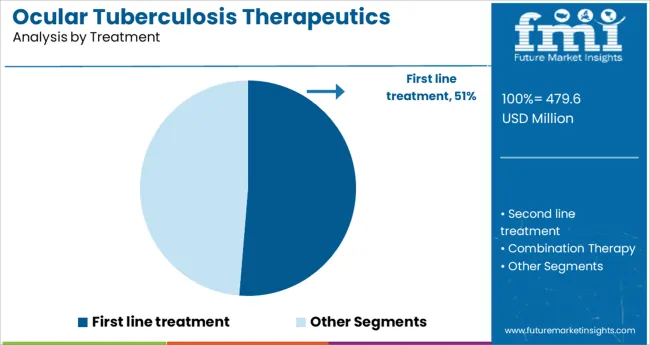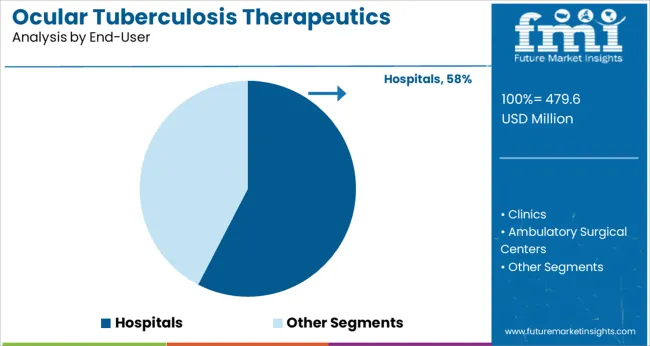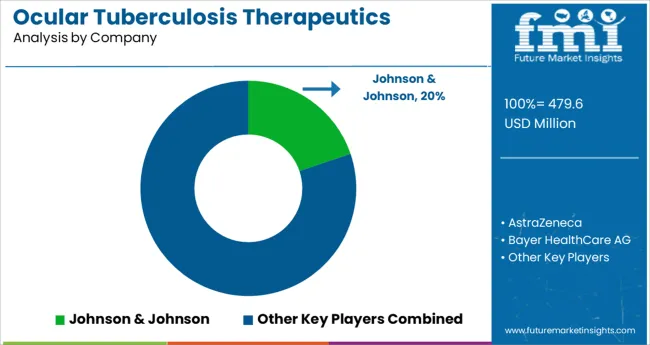The Ocular Tuberculosis Therapeutics Market is estimated to be valued at USD 479.6 million in 2025 and is projected to reach USD 842.9 million by 2035, registering a compound annual growth rate (CAGR) of 5.8% over the forecast period.

The ocular tuberculosis therapeutics market is growing steadily due to the increasing incidence of tuberculosis infections that affect the eye, especially in regions with high tuberculosis prevalence. Medical professionals have recognized the importance of early and effective treatment to prevent vision loss and complications associated with ocular tuberculosis.
Advances in diagnostic tools have improved the identification of ocular tuberculosis, facilitating timely therapeutic intervention. The rising focus on infectious disease control and expanding healthcare infrastructure have also contributed to market growth.
Increased availability of targeted treatments in hospitals and specialized eye care centers has improved patient outcomes. Furthermore, public health initiatives aimed at tuberculosis eradication have supported access to first line treatment options. As awareness about ocular tuberculosis rises and treatment protocols become more standardized, the market is expected to continue expanding.
The market is segmented by Treatment and End-User and region. By Treatment, the market is divided into First line treatment, Second line treatment, and Combination Therapy. In terms of End-User, the market is classified into Hospitals, Clinics, and Ambulatory Surgical Centers. Regionally, the market is classified into North America, Latin America, Western Europe, Eastern Europe, Balkan & Baltic Countries, Russia & Belarus, Central Asia, East Asia, South Asia & Pacific, and the Middle East & Africa.

The first line treatment segment is projected to hold 51.3% of the ocular tuberculosis therapeutics market revenue in 2025. This segment has been driven by its role as the primary therapy option for managing ocular tuberculosis effectively. These treatments are favored due to their established efficacy in controlling infection and preventing disease progression.
Medical guidelines recommend first line treatment protocols as the standard care for most ocular tuberculosis cases, which has ensured broad clinical adoption. Additionally, first line treatments have been preferred because of their relatively well-understood safety profiles and availability in hospital settings.
As treatment guidelines continue to emphasize early intervention to prevent irreversible eye damage, the first line treatment segment is expected to maintain its dominance.

The hospitals segment is anticipated to represent 57.6% of the ocular tuberculosis therapeutics market revenue in 2025, positioning it as the leading end-user segment. Hospitals are preferred due to their capacity to provide comprehensive care, including diagnosis, treatment, and follow-up for complex ocular tuberculosis cases.
The presence of specialized ophthalmology departments and infectious disease units enables hospitals to manage patients with multidisciplinary approaches. The segment’s growth has been supported by investments in healthcare infrastructure and increased access to diagnostic facilities.
Moreover, hospitals are equipped to handle the administration and monitoring of treatment regimens, particularly for patients requiring close observation. As healthcare systems continue to prioritize infectious disease management, hospitals are expected to remain the primary end users of ocular tuberculosis therapeutics.
When given in the correct dosage, the various combination of drugs leads to the prevention of incidence of ocular tuberculosis, curing the disease. This factor is driving the market for ocular tuberculosis therapeutics.
Moreover, the growth of the ocular tuberculosis therapeutics market can be attributed to the rising demand for improved therapeutics that can treat tuberculosis, including ocular tuberculosis.
Furthermore, combination therapy in the ocular tuberculosis therapeutics market is being highly adopted because of the growing prevalence of multi-drug resistant tuberculosis.
In addition to this, the first-line drugs lie Rifampicin, Ethambutol, Isoniazid, and Pyrazinamide, which are being used at the initial stage of tuberculosis and are having high demand in the therapeutics market. Some second-line drugs in high demand are Fluoroquinolones, Cycloserine, Thioamides, and others. It is anticipated that the demand for these drugs is a key driving factor in the ocular tuberculosis therapeutics market and is likely to boost the demand for the product during the forecast period.
Furthermore, it is projected that the increased funding I clinical research and healthcare by both public and private institutions, along with government organizations, is a major factor leading to the expansion of the ocular tuberculosis therapeutics market.
It is anticipated that there is a lack of medical check-up protocol, which is expected to hinder the growth of the ocular tuberculosis therapeutics market over the upcoming years.
Furthermore, ocular tuberculosis is a very rare condition and is currently undergoing study and research. In regards to this, there is very limited availability of necessary therapeutics or other drugs for the treatment of tuberculosis in the eye. This factor is estimated to curb the growth of the ocular tuberculosis therapeutics market.

North America is projected to hold the largest market share of the ocular tuberculosis therapeutics market. It is currently accountable for 36.0% of the total market share for the ocular tuberculosis therapeutics market.
This expansion and growth in the North American regions can be attributed to the increasing number of developments in the healthcare industry.
It is also anticipated that the North American region has a growing demand for better and advanced tuberculosis therapies, which is driving the expansion of the market size of the ocular tuberculosis therapeutics market.
The European region has a potential growth outlook for the ocular tuberculosis therapeutics market. It is currently accountable for 27.9% of the total market share of the ocular tuberculosis therapeutics market.
The growing demand for ocular tuberculosis therapeutics in this region is due to the increasing population of this region, coupled with rising disposable income, which is driving the populace to undergo therapies that cure ocular tuberculosis faster.
In addition to that, there are research grants offered by various organizations in this region in ocular tuberculosis therapeutics to bring in more product developments.
How are New Entrants Revolutionizing the Ocular Tuberculosis Therapeutics Market?
The start-up ecosystem in the ocular tuberculosis therapeutics market is intense with frequent innovations being made. Start-ups in the ocular tuberculosis therapeutics market are focusing on improvising the therapeutics for faster cure delivery to the patients.
Indian start-up Everwell has developed HealthTech technologies for patient adherence. The start-up’s digital adherence technology, 99DOTS, uses low-cost packaging with hidden codes to encourage patients to take their medications daily. It requires the patient to register daily adherence by communicating the hidden code via a toll-free call, SMS, or other channels.
Quartis, is a South Korean startup developing a novel TB vaccine. The start-up’s subunit vaccine, QTP101, target multiple antigens associated with virulence and latency.
Swedish start-up Astrego offers in-vitro diagnostics solutions to tackle antimicrobial resistance. The start-up’s PA-100 system uses a desktop instrument and specific panels for rapid screening. The auto-mated solution provides personalized antibiotic prescriptions for tuberculosis, as well as urinary tract infections, respiratory conditions, and sepsis.

Who are some of the Key Market Players in the Ocular Tuberculosis Therapeutics Market?
Some of the ocular tuberculosis therapeutics market participants are AstraZeneca, Bayer HealthCare AG, Biological E, BioVersys, Cadila Pharmaceuticals, Concept Pharmaceuticals Ltd., Infectex, Johnson & Johnson, Labatec-Pharma SA, Lupin Pharmaceuticals Inc., Macleods Pharmaceuticals Ltd., Maneesh Pharmaceuticals, Novartis, Otsuka Novel Products, Pfizer, Pharmasyntez, Sandoz, Sanofi, Sequella, Inc., and Themis Medicare Ltd.
The key players in the market are involving themselves in the development of improvised therapeutics. They are receiving raised initiatives by the government for the promotion of research and development activities for bringing advanced solutions for ocular tuberculosis and fast-cure range of therapeutics in the global ocular tuberculosis therapeutics market
Some key developments in the ocular tuberculosis therapeutics market are:
| Report Attribute | Details |
|---|---|
| Growth Rate | CAGR of 5.8% from 2025 to 2035 |
| Base Year for Estimation | 2024 |
| Historical Data | 2020 to 2024 |
| Forecast Period | 2025 to 2035 |
| Quantitative Units | Revenue in million and CAGR from 2025 to 2035 |
| Report Coverage | Revenue Forecast, Volume Forecast, Company Ranking, Competitive Landscape, Growth Factors, Trends and Pricing Analysis |
| Segments Covered | Treatment, End User, Region |
| Regions Covered | North America; Latin America; Europe; East Asia; South Asia; Oceania; Middle East and Africa |
| Key Countries Profiled | USA, Canada, Brazil, Argentina, Germany, UK, France, Spain, Italy, Nordics, BENELUX, Australia & New Zealand, China, India, ASEAN, GCC, South Africa |
| Key Companies Profiled | AstraZeneca; Bayer HealthCare AG; Biological E; BioVersys; Cadila Pharmaceuticals; Concept Pharmaceuticals Ltd.; Infectex, Johnson & Johnson; Labatec-Pharma SA; Lupin Pharmaceuticals Inc.; Macleods Pharmaceuticals Ltd.; Maneesh Pharmaceuticals; Novartis; Otsuka Novel Products; Pfizer; Pharmasyntez; Sandoz; Sanofi; Sequella, Inc.; Themis Medicare Ltd. |
| Customization | Available Upon Request |
The global ocular tuberculosis therapeutics market is estimated to be valued at USD 479.6 million in 2025.
It is projected to reach USD 842.9 million by 2035.
The market is expected to grow at a 5.8% CAGR between 2025 and 2035.
The key product types are first line treatment, second line treatment and combination therapy.
hospitals segment is expected to dominate with a 57.6% industry share in 2025.






Full Research Suite comprises of:
Market outlook & trends analysis
Interviews & case studies
Strategic recommendations
Vendor profiles & capabilities analysis
5-year forecasts
8 regions and 60+ country-level data splits
Market segment data splits
12 months of continuous data updates
DELIVERED AS:
PDF EXCEL ONLINE
Ocular Allergy Diagnostic System Market Size and Share Forecast Outlook 2025 to 2035
Ocular Drug Delivery System Market – Trends & Forecast 2025 to 2035
Ocular Immunosuppressants Market Trends – Size, Share & Forecast 2024-2034
Ocular Implants Market
Ocular Sealants and Glues Market
Binoculars and Mounting Solutions Market Growth - Trends & Forecast 2025 to 2035
Intraocular Lens Market Size and Share Forecast Outlook 2025 to 2035
Intraocular Lymphoma Treatment Market Insights by Drug Class, Mode of Administration, Distribution Channel, End User, and Region through 2035
Phakic Intraocular Lenses (IOL) Market Analysis - Size, Share & Forecast 2025 to 2035
Tuberculosis Diagnostics Market
Tuberculosis Therapeutics Market Size and Share Forecast Outlook 2025 to 2035
Mycobacterium Tuberculosis PCR Detection Kits Market Size and Share Forecast Outlook 2025 to 2035
Mycobacterium Tuberculosis Testing Market
Drug Resistant Pulmonary Tuberculosis Market
Biotherapeutics Virus Removal Filters Market Trends – Growth & Forecast 2025 to 2035
COPD Therapeutics Market Report – Growth, Demand & Industry Forecast 2023-2033
Digital Therapeutics and Wellness Market Size and Share Forecast Outlook 2025 to 2035
Digital Therapeutics Market Size and Share Forecast Outlook 2025 to 2035
Peptide Therapeutics Market Analysis - Growth & Forecast 2024 to 2034
Advanced Therapeutics Pharmaceutical Outsourcing Market Size and Share Forecast Outlook 2025 to 2035

Thank you!
You will receive an email from our Business Development Manager. Please be sure to check your SPAM/JUNK folder too.
Chat With
MaRIA